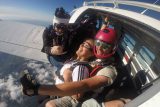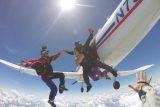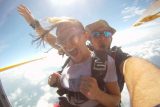A typical skydive lasts five to six minutes, with approximately 50 seconds of that spent in freefall and four to five minutes on the parachute ride down. How long a skydive lasts is dependent on various factors, including altitude, weight and equipment used.
It doesn’t sound like long, does it? But believe us – it’ll be the longest 50 seconds of your life! That’s because you’ll experience so many new sensory stimulations, meaning you’ll be more alert – and time will feel slower – than ever before. Here, we’ll explore some of the factors that affect how long your skydive lasts.
How long does freefall last?
Freefall is the period of the skydive where you’re literally falling toward the earth. Having exited the aircraft, you’ll accelerate to your ‘terminal velocity’ and keep falling at that speed until it’s time to deploy your parachute.
The amount of time you’ll spend in freefall is typically around 50 seconds. But this can change, depending on altitude, weight and type of jump.
For example, tandem skydivers usually leave the aircraft at an altitude of 13,500 feet, then deploy their parachute at 5,000 feet. We calculate freefall time at 10 seconds for the first 1,000 feet and then 5 seconds for every 1,000 feet thereafter. This means you’d spend 50 seconds in freefall.
For skydivers who are jumping solo and in, for example, a standing up position, the rate of descent is faster, meaning less time in freefall. Experienced jumpers exiting at 13,500 feet and falling in this faster position will expect 35-40 seconds of freefall time.
How fast do you freefall?
Freefall speeds are dependent on various factors too, including weight and body position.
A stable belly-to-earth body position will usually result in a ‘terminal velocity’ (this being the fastest speed you’ll reach during freefall) of 120mph or 200kph. A stable head down position (falling upside with your head toward the ground and legs up) gets around 150-180mph (240-290kph).
Typically, terminal velocity for a tandem skydive is somewhere around 125mph – a little faster than a solo skydiver, due to the fact a tandem is two people together, but slower than head down skydiving. Tandem skydivers use something called a ‘drogue’ for additional support, and this slows the rate of descent slightly.
The fastest skydiver ever was Henrik Raimer of Sweden, who achieved 373.6mph (601.26kph) during a speed skydiving competition in Chicago in 2016.
How long does it take to fly down under your parachute?
The length of time it takes to fly down to earth under the parachute is dependent on the deployment height, parachute size, and weight.
Tandem skydivers usually deploy their parachute at 5,000 feet. As there are two people sharing one parachute, tandem parachutes are much larger than those used by solo skydivers – usually, over 300 square feet, compared to half that for solo jumpers. This results in a time under parachute of four to five minutes.
Skydivers can increase the rate of their parachute’s descent by turning the parachute. When you turn your parachute, it points toward the ground and is, therefore, traveling down faster than it does when it’s going straight forward. The practice of ‘swooping’ in skydiving is all about increasing the rate of the parachute’s descent, creating faster speeds across the ground. An experienced, solo skydiver will usually spend two to three minutes under their parachute.
How long should I expect to be at the skydiving center?
Though the actual skydive itself lasts around five minutes, the overall experience is much longer.
A large part of the skydiving experience is, of course, the airplane ride up to altitude. Our Pac750 XL aircraft will take around 10-12 minutes to reach our exit altitude of 13,500 feet. Different aircraft will take more or less time.
As a tandem skydiver, you’ll be invited to come to the skydiving center in the morning. On arrival, you’ll be signed on by a member of our friendly team and a tandem skydiving instructor will prepare you for your jump with a brief that takes around 20 minutes. Depending on the time you arrive, you may be asked to wait in line while other tandem skydivers make their jump. In some cases, adverse weather conditions may mean operations are put on hold until it is safe again to jump.
All of this means that you can expect to be at the skydiving center for your skydive for a few hours. During that time, you’ll be able to relax in our facilities and watch other skydivers from our spectator area as they come in to land.
When you consider that this is an experience you’ll remember for the rest of your life, it’s a very short amount of time to spend doing it. Many of our customers choose to add a video package to their jump so they can relive the experience again and again.
Are you ready to skydive? Book online today, or get in touch and we’ll be happy to answer any questions you may have.





